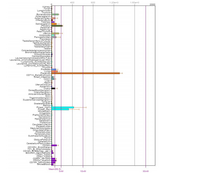
Multidrug resistance-associated protein 1 (MRP1) is a protein that in humans is encoded by the ABCC1 gene.

Potassium voltage-gated channel subfamily E member 4, originally named MinK-related peptide 3 or MiRP3 when it was discovered, is a protein that in humans is encoded by the KCNE4 gene.

Receptor expression-enhancing protein 5 is a protein that in humans is encoded by the REEP5 gene. Receptor Expression Enhancing Protein is a protein encoded for in Humans by the REEP5 gene.

Killer cell immunoglobulin-like receptor 3DL3 is a protein that in humans is encoded by the KIR3DL3 gene.

Transmembrane protein 126A is a mitochondrial transmembrane protein of unknown function coded for by the TMEM126A gene.

Zinc finger protein 300 is a protein that in humans is encoded by the ZNF300 gene. The protein encoded by this gene is a C2H2-type zinc finger DNA binding protein and a likely transcription factor.

Rh blood group, D antigen also known as Rh polypeptide 1 (RhPI) or cluster of differentiation 240D (CD240D) is a protein that in humans is encoded by the RHD gene.

Alpha-1-B glycoprotein is a 54.3 kDa protein in humans that is encoded by the A1BG gene. The protein encoded by this gene is a plasma glycoprotein of unknown function. The protein shows sequence similarity to the variable regions of some immunoglobulin supergene family member proteins. Patients who have pancreatic ductal adenocarcinoma show an overexpression of A1BG in pancreatic juice.

Chitinase domain-containing protein 1 (CHID1) is a highly conserved protein of unknown function located on the short (p) arm of chromosome 11 near the telomere. The protein has 27 introns, which allows for many isoforms of this gene. It has several aliases, the most common of which is Stabilin-1 interacting chitinase-like protein (SI-CLP). As indicated by the alias, CHID1 is known to interact with the protein STAB1. CHID1 is expressed ubiquitously at levels nearly 6 times the average gene, and is conserved very far back to organisms such as Caenorhabditis elegans and possibly some prokaryotes. This protein is known to have carbohydrate binding sites, which could be involved in carbohydrate catabolysis.

STEAP family member 4 is a protein that in humans is encoded by the STEAP4 gene.

ABHD18 is a protein that in Homo sapiens is encoded by the ABHD18 gene.

Spermatogenesis associated serine rich 1 (SPATS1) is a protein which in humans is encoded by the SPATS1 gene. It is also known by the aliases Dishevelled-DEP domain interacting protein (DDIP), Spermatogenesis Associated 8 (SPATA8), and serin-rich spermatogenic protein 1 (SRSP1). A general idea of its chemical structure, subcellular localization, expression, and conservation is known. Research suggests SPATS1 may play a role in the canonical Wnt Signaling pathway and in the first spermatogenic wave.
Transmembrane Protein 217 is a protein encoded by the gene TMEM217. TMEM217 has been found to have expression correlated with the lymphatic system and endothelial tissues and has been predicted to have a function linked to the cytoskeleton.

SHLD1 or shieldin complex subunit 1 is a gene on chromosome 20. The C20orf196 gene encodes an mRNA that is 1,763 base pairs long, and a protein that is 205 amino acids long.

Chromosome 9 open reading frame 43 is a protein that in humans is encoded by the C9orf43 gene. The gene is also known as MGC17358 and LOC257169. C9orf43 contains DUF 4647 and a polyglutamine repeat region although protein function is not well understood.

Chromosome 19 open reading frame 44 is a protein that in humans is encoded by the C19orf44 gene. C19orf44 is an uncharacterized protein with an unknown function in humans. C19orf44 is non-limiting implying that the protein exists in other species besides human. The protein contains one domain of unknown function (DUF) that is highly conserved throughout its orthologs. This protein is most highly expressed in the testis and ovary, but also has significant expression in the thyroid and parathyroid. Other names for this protein include: LOC84167.

Transmembrane protein 171 (TMEM171) is a protein that in humans is encoded by the TMEM171 gene.

Transmembrane protein 179 is a protein that in humans is encoded by the TMEM179 gene. The function of transmembrane protein 179 is not yet well understood, but it is believed to have a function in the nervous system.

Coiled-Coil Domain Containing 190, also known as C1orf110, the Chromosome 1 Open Reading Frame 110, MGC48998 and CCDC190, is found to be a protein coding gene widely expressed in vertebrates. RNA-seq gene expression profile shows that this gene selectively expressed in different organs of human body like lung brain and heart. The expression product of c1orf110 is often called Coiled-coil domain-containing protein 190 with a size of 302 aa. It may get the name because a coiled-coil domain is found from position 14 to 72. At least 6 spliced variants of its mRNA and 3 isoforms of this protein can be identified, which is caused by alternative splicing in human.

GPATCH2L is a protein that is encoded by the GPATCH2L human gene located at 14q24.3. In humans, the length of mRNA in GPATCH2L (NM_017926) is 14,021 base pairs and the gene spans bases is 62,422 nt between chr14: 76,151,922 - 76,214,343. GPATCH2L is on the positive strand. IFT43 is the gene directly before GPATCH2L on the positive strand and LOC105370575 is the uncharacterized gene on the negative strand, which is approximately one and a half the size of GPATCH2L. Known aliases for GPATCH2L contain C14orf118, FLJ20689, FLJ10033, and KIAA1152. GPATCH2L produces 28 distinct introns, 17 different mRNAs, 14 alternatively spliced variants, and 3 unspliced forms. It has 5 probable alternative promoters, 7 validated polyadenylation sites, and 6 predicted promoters of varying lengths.


















